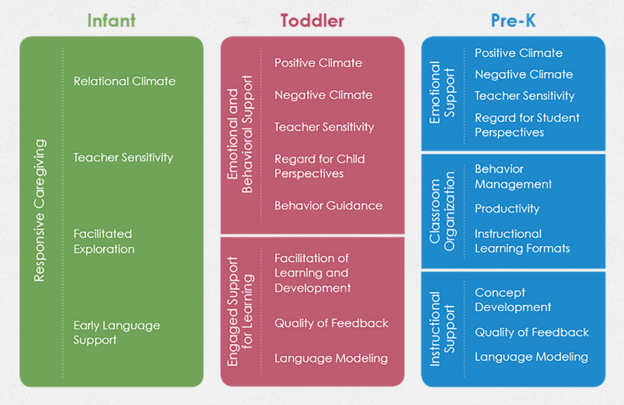
So, your program is using the CLASS observation tool in pre-K classrooms. That’s wonderful! Here are a few things to think about as you consider transitioning to include use of the CLASS at the infant and toddler age levels as well.
CLASS Is Individualized for Each Age Level
Before looking at the benefits of implementing CLASS in earlier age levels, it’s important to first look at how the tool varies. Because children learn differently as they grow, the CLASS has varying domains and dimensions at six age levels.
Take a look at the chart below to see how the tool is broken up at the first three age levels—from a single domain at the infant level, to the three domains in pre-K classrooms.

CLASS Provides a Common Language among Teachers between Age Levels
Infant and toddler teachers can feel isolated from their teaching peers because their daily routines are so different. They tend to be perceived as something between caregiver and teacher—or worse, a babysitter.
It’s vital for the professional development of these teachers (because they are teachers) to ensure they join the larger conversation of early childhood education. CLASS provides a common language among all teachers. After all, quality interactions with teachers are critical for every child, from newborns through 12th grade! CLASS can become your teachers’ universal language for how to interact with children.
CLASS Strengthens Relationships
Infants are growing through their interactions with teachers. They’re learning to trust, to communicate, and to navigate the world for the first time. For that reason alone, you can begin to understand why implementing CLASS as early as possible can be vital to the outcomes of these children.
Imagine an experience where 3-month-old Liam is enrolled in a child care center. His teacher, Miss Mary-Ellen, understands the need to learn his unique needs, discover what interests him, and encourage Liam as he learns new skills. During his time in the infant classroom, his relationship with his teacher strengthens. As the time nears for him to transition to the toddler classroom, Miss Mary-Ellen can prepare her colleagues to welcome Liam. She can help to ensure a smooth transition by sharing about the interactions that she’s found helpful in working with Liam. His new teacher, Miss Jasmine, can then focus her attention to support his emotional and behavioral growth as well as engaging him in learning.
Before Liam starts preschool, he has had four years of quality interactions with teachers. He has built up trust in teachers to provide him with warm, safe, and nurturing experiences. He’s been challenged to become more autonomous and explore his natural curiosity about life. He is more prepared to try new things, excited to build friendships, and motivated to learn.
Teachstone Can Provide Support to Teachers at All Age Levels
Once teachers in your organization are using CLASS at every age level, you don’t have to shop around for support. Teachstone can help teachers grow no matter what age they teach.
If you have questions about using the CLASS tool at the infant age level, consider Learn About Infant CLASS Dimensions. You’ll be introduced to the four dimensions that make up the tool in four 15-minute online courses.

